Business Law - Study Material and Solved Assignments
VerifiedAdded on 2023/06/11
|9
|2334
|325
AI Summary
This article provides an overview of Business Law, covering topics such as the Australian Constitution, doctrine of precedent, alternative dispute resolution, company creation, partnership, franchise, trusts, negligence, superannuation, and tax. It also includes references to relevant cases and legislation.
Contribute Materials
Your contribution can guide someone’s learning journey. Share your
documents today.
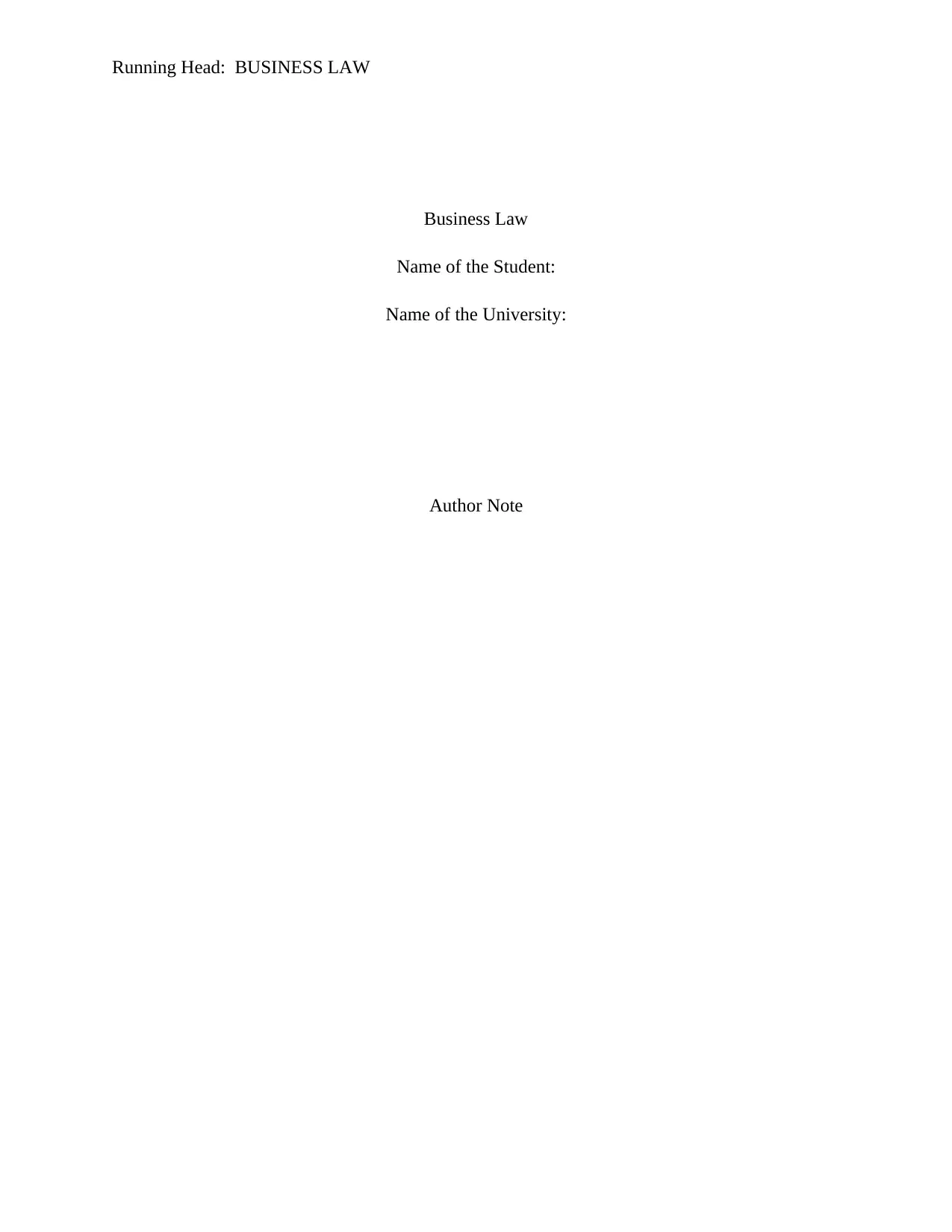
Running Head: BUSINESS LAW
Business Law
Name of the Student:
Name of the University:
Author Note
Business Law
Name of the Student:
Name of the University:
Author Note
Secure Best Marks with AI Grader
Need help grading? Try our AI Grader for instant feedback on your assignments.
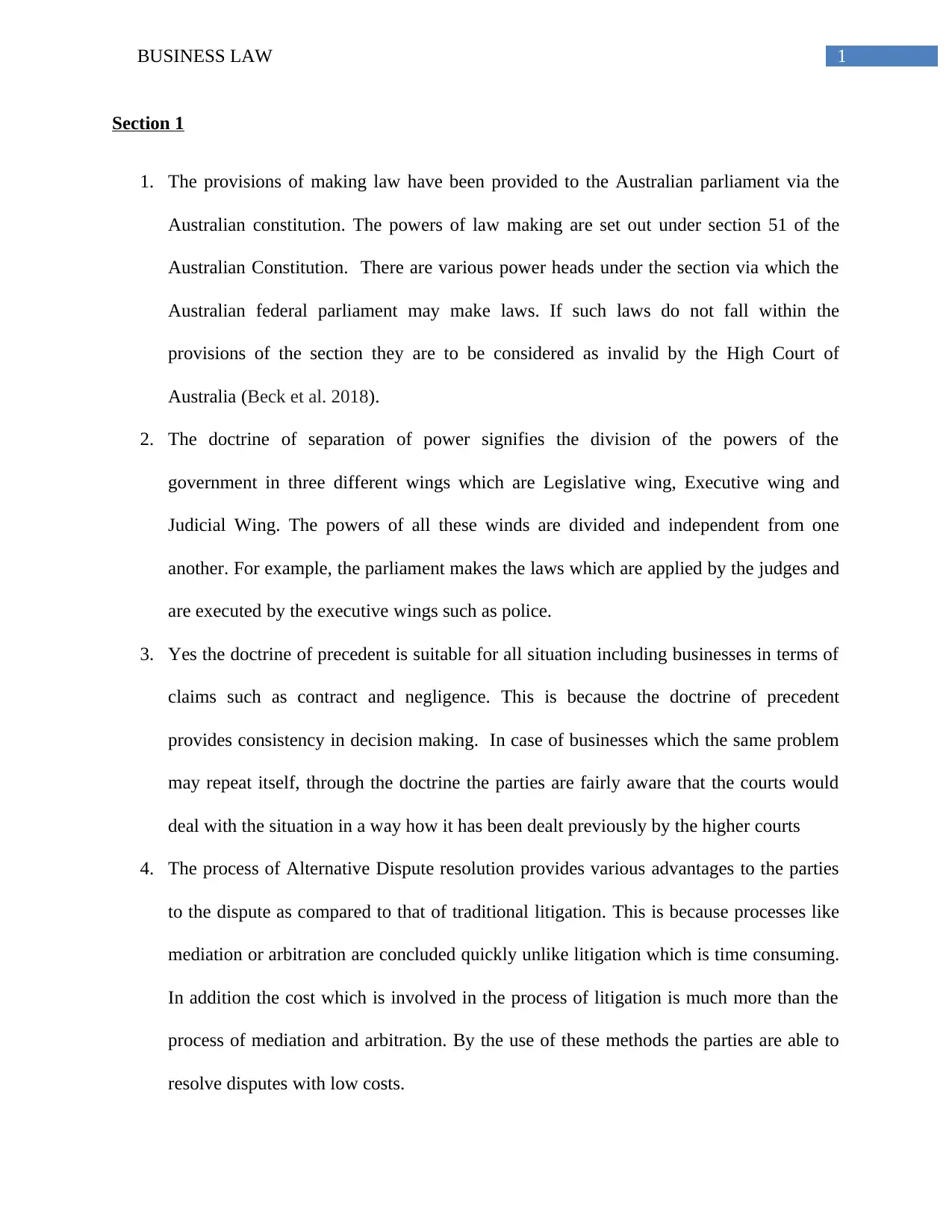
1BUSINESS LAW
Section 1
1. The provisions of making law have been provided to the Australian parliament via the
Australian constitution. The powers of law making are set out under section 51 of the
Australian Constitution. There are various power heads under the section via which the
Australian federal parliament may make laws. If such laws do not fall within the
provisions of the section they are to be considered as invalid by the High Court of
Australia (Beck et al. 2018).
2. The doctrine of separation of power signifies the division of the powers of the
government in three different wings which are Legislative wing, Executive wing and
Judicial Wing. The powers of all these winds are divided and independent from one
another. For example, the parliament makes the laws which are applied by the judges and
are executed by the executive wings such as police.
3. Yes the doctrine of precedent is suitable for all situation including businesses in terms of
claims such as contract and negligence. This is because the doctrine of precedent
provides consistency in decision making. In case of businesses which the same problem
may repeat itself, through the doctrine the parties are fairly aware that the courts would
deal with the situation in a way how it has been dealt previously by the higher courts
4. The process of Alternative Dispute resolution provides various advantages to the parties
to the dispute as compared to that of traditional litigation. This is because processes like
mediation or arbitration are concluded quickly unlike litigation which is time consuming.
In addition the cost which is involved in the process of litigation is much more than the
process of mediation and arbitration. By the use of these methods the parties are able to
resolve disputes with low costs.
Section 1
1. The provisions of making law have been provided to the Australian parliament via the
Australian constitution. The powers of law making are set out under section 51 of the
Australian Constitution. There are various power heads under the section via which the
Australian federal parliament may make laws. If such laws do not fall within the
provisions of the section they are to be considered as invalid by the High Court of
Australia (Beck et al. 2018).
2. The doctrine of separation of power signifies the division of the powers of the
government in three different wings which are Legislative wing, Executive wing and
Judicial Wing. The powers of all these winds are divided and independent from one
another. For example, the parliament makes the laws which are applied by the judges and
are executed by the executive wings such as police.
3. Yes the doctrine of precedent is suitable for all situation including businesses in terms of
claims such as contract and negligence. This is because the doctrine of precedent
provides consistency in decision making. In case of businesses which the same problem
may repeat itself, through the doctrine the parties are fairly aware that the courts would
deal with the situation in a way how it has been dealt previously by the higher courts
4. The process of Alternative Dispute resolution provides various advantages to the parties
to the dispute as compared to that of traditional litigation. This is because processes like
mediation or arbitration are concluded quickly unlike litigation which is time consuming.
In addition the cost which is involved in the process of litigation is much more than the
process of mediation and arbitration. By the use of these methods the parties are able to
resolve disputes with low costs.
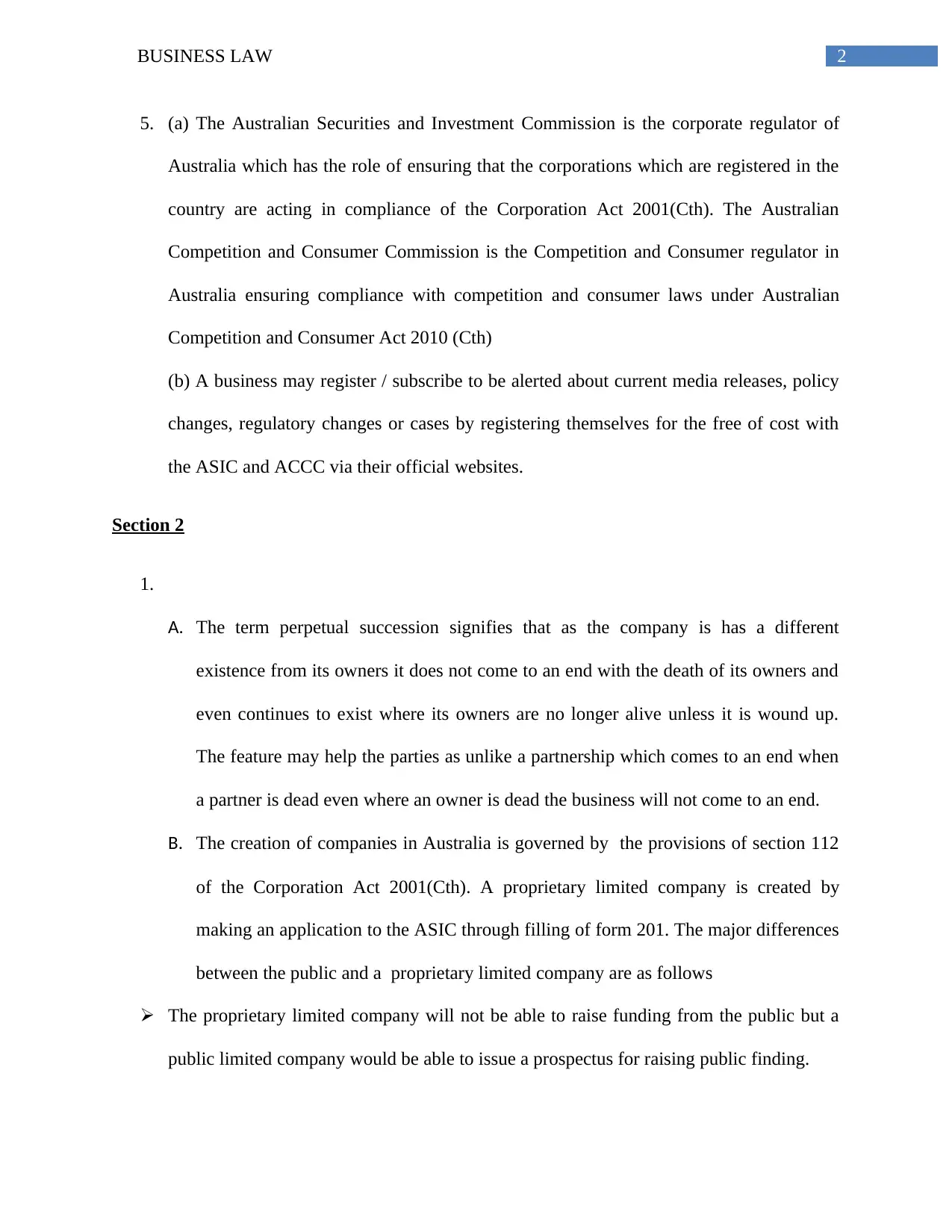
2BUSINESS LAW
5. (a) The Australian Securities and Investment Commission is the corporate regulator of
Australia which has the role of ensuring that the corporations which are registered in the
country are acting in compliance of the Corporation Act 2001(Cth). The Australian
Competition and Consumer Commission is the Competition and Consumer regulator in
Australia ensuring compliance with competition and consumer laws under Australian
Competition and Consumer Act 2010 (Cth)
(b) A business may register / subscribe to be alerted about current media releases, policy
changes, regulatory changes or cases by registering themselves for the free of cost with
the ASIC and ACCC via their official websites.
Section 2
1.
A. The term perpetual succession signifies that as the company is has a different
existence from its owners it does not come to an end with the death of its owners and
even continues to exist where its owners are no longer alive unless it is wound up.
The feature may help the parties as unlike a partnership which comes to an end when
a partner is dead even where an owner is dead the business will not come to an end.
B. The creation of companies in Australia is governed by the provisions of section 112
of the Corporation Act 2001(Cth). A proprietary limited company is created by
making an application to the ASIC through filling of form 201. The major differences
between the public and a proprietary limited company are as follows
The proprietary limited company will not be able to raise funding from the public but a
public limited company would be able to issue a prospectus for raising public finding.
5. (a) The Australian Securities and Investment Commission is the corporate regulator of
Australia which has the role of ensuring that the corporations which are registered in the
country are acting in compliance of the Corporation Act 2001(Cth). The Australian
Competition and Consumer Commission is the Competition and Consumer regulator in
Australia ensuring compliance with competition and consumer laws under Australian
Competition and Consumer Act 2010 (Cth)
(b) A business may register / subscribe to be alerted about current media releases, policy
changes, regulatory changes or cases by registering themselves for the free of cost with
the ASIC and ACCC via their official websites.
Section 2
1.
A. The term perpetual succession signifies that as the company is has a different
existence from its owners it does not come to an end with the death of its owners and
even continues to exist where its owners are no longer alive unless it is wound up.
The feature may help the parties as unlike a partnership which comes to an end when
a partner is dead even where an owner is dead the business will not come to an end.
B. The creation of companies in Australia is governed by the provisions of section 112
of the Corporation Act 2001(Cth). A proprietary limited company is created by
making an application to the ASIC through filling of form 201. The major differences
between the public and a proprietary limited company are as follows
The proprietary limited company will not be able to raise funding from the public but a
public limited company would be able to issue a prospectus for raising public finding.
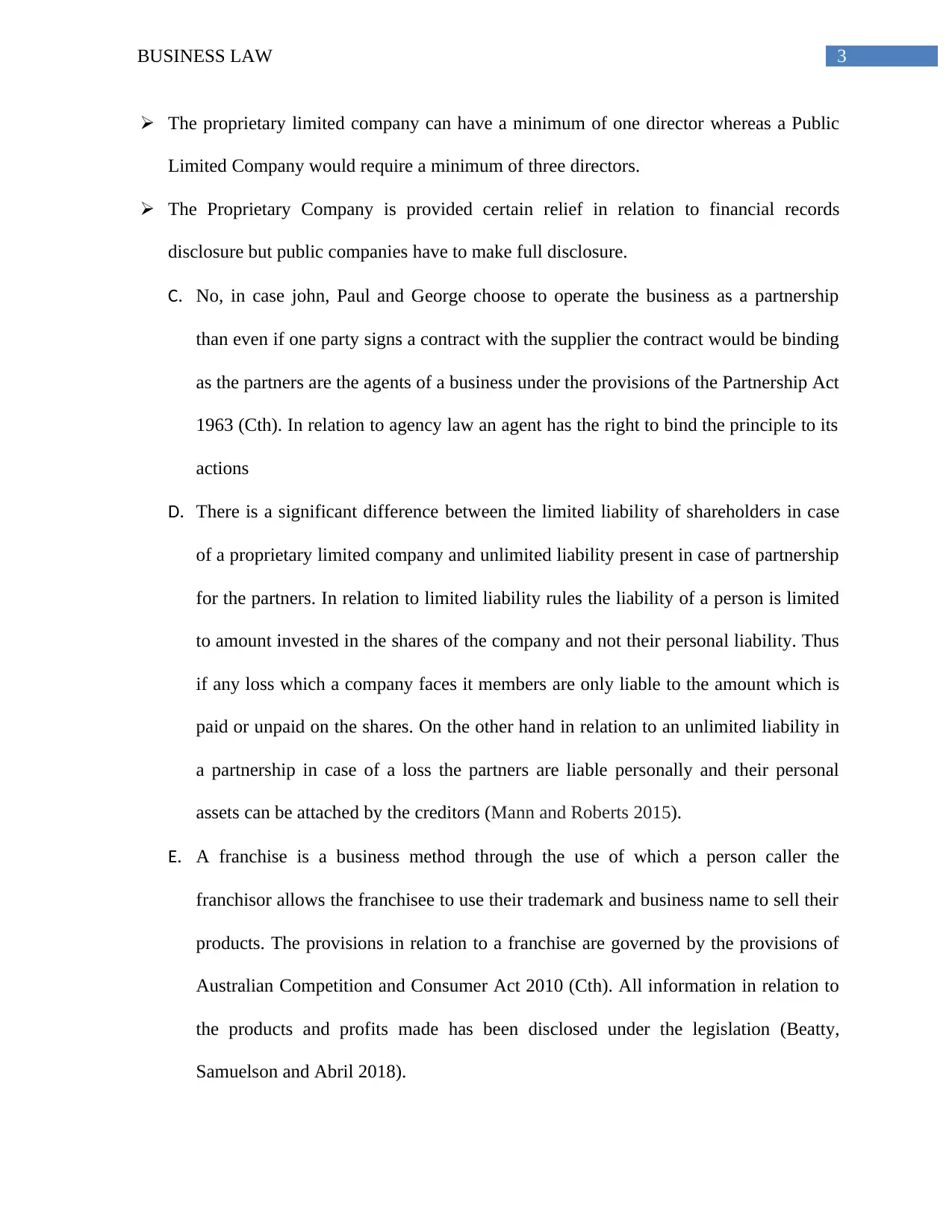
3BUSINESS LAW
The proprietary limited company can have a minimum of one director whereas a Public
Limited Company would require a minimum of three directors.
The Proprietary Company is provided certain relief in relation to financial records
disclosure but public companies have to make full disclosure.
C. No, in case john, Paul and George choose to operate the business as a partnership
than even if one party signs a contract with the supplier the contract would be binding
as the partners are the agents of a business under the provisions of the Partnership Act
1963 (Cth). In relation to agency law an agent has the right to bind the principle to its
actions
D. There is a significant difference between the limited liability of shareholders in case
of a proprietary limited company and unlimited liability present in case of partnership
for the partners. In relation to limited liability rules the liability of a person is limited
to amount invested in the shares of the company and not their personal liability. Thus
if any loss which a company faces it members are only liable to the amount which is
paid or unpaid on the shares. On the other hand in relation to an unlimited liability in
a partnership in case of a loss the partners are liable personally and their personal
assets can be attached by the creditors (Mann and Roberts 2015).
E. A franchise is a business method through the use of which a person caller the
franchisor allows the franchisee to use their trademark and business name to sell their
products. The provisions in relation to a franchise are governed by the provisions of
Australian Competition and Consumer Act 2010 (Cth). All information in relation to
the products and profits made has been disclosed under the legislation (Beatty,
Samuelson and Abril 2018).
The proprietary limited company can have a minimum of one director whereas a Public
Limited Company would require a minimum of three directors.
The Proprietary Company is provided certain relief in relation to financial records
disclosure but public companies have to make full disclosure.
C. No, in case john, Paul and George choose to operate the business as a partnership
than even if one party signs a contract with the supplier the contract would be binding
as the partners are the agents of a business under the provisions of the Partnership Act
1963 (Cth). In relation to agency law an agent has the right to bind the principle to its
actions
D. There is a significant difference between the limited liability of shareholders in case
of a proprietary limited company and unlimited liability present in case of partnership
for the partners. In relation to limited liability rules the liability of a person is limited
to amount invested in the shares of the company and not their personal liability. Thus
if any loss which a company faces it members are only liable to the amount which is
paid or unpaid on the shares. On the other hand in relation to an unlimited liability in
a partnership in case of a loss the partners are liable personally and their personal
assets can be attached by the creditors (Mann and Roberts 2015).
E. A franchise is a business method through the use of which a person caller the
franchisor allows the franchisee to use their trademark and business name to sell their
products. The provisions in relation to a franchise are governed by the provisions of
Australian Competition and Consumer Act 2010 (Cth). All information in relation to
the products and profits made has been disclosed under the legislation (Beatty,
Samuelson and Abril 2018).
Secure Best Marks with AI Grader
Need help grading? Try our AI Grader for instant feedback on your assignments.
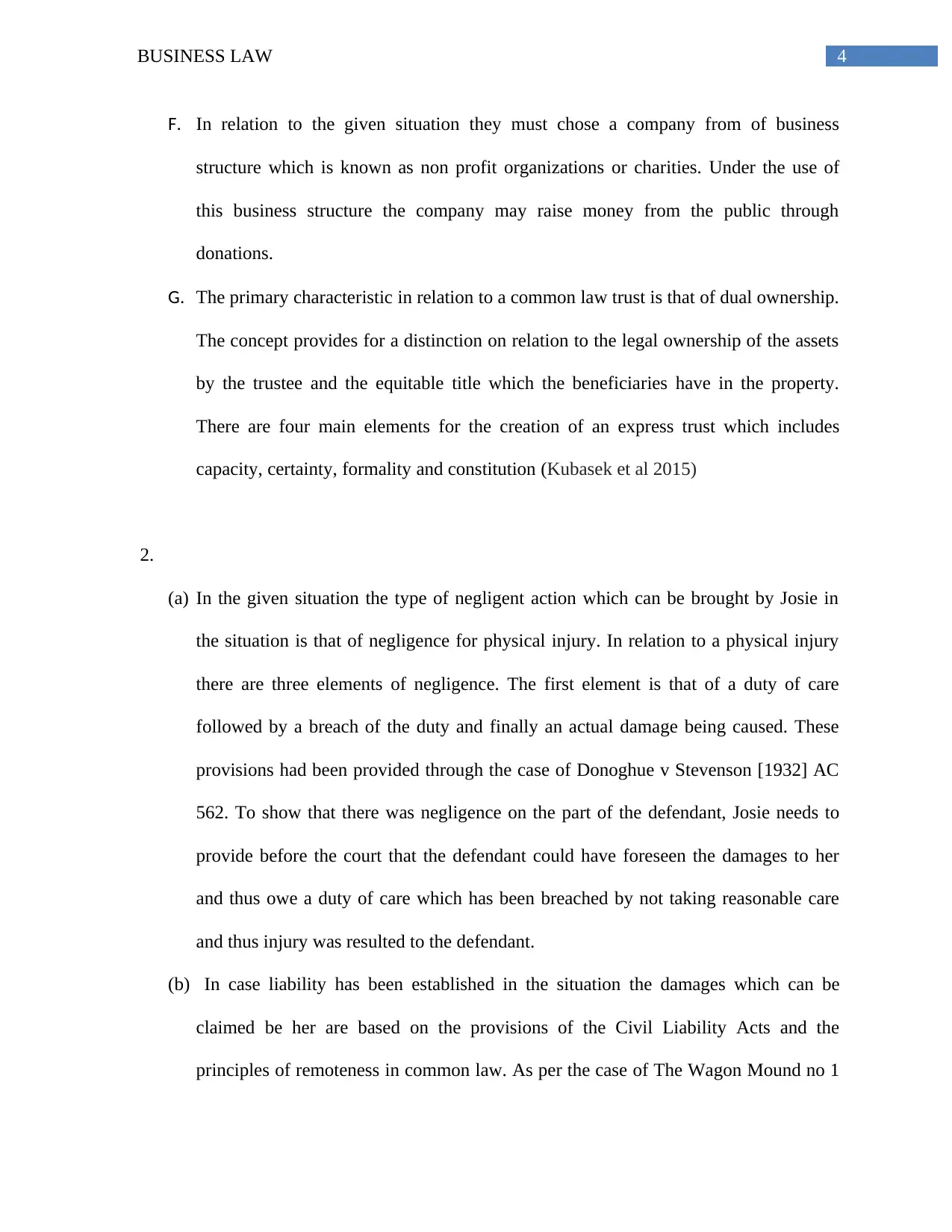
4BUSINESS LAW
F. In relation to the given situation they must chose a company from of business
structure which is known as non profit organizations or charities. Under the use of
this business structure the company may raise money from the public through
donations.
G. The primary characteristic in relation to a common law trust is that of dual ownership.
The concept provides for a distinction on relation to the legal ownership of the assets
by the trustee and the equitable title which the beneficiaries have in the property.
There are four main elements for the creation of an express trust which includes
capacity, certainty, formality and constitution (Kubasek et al 2015)
2.
(a) In the given situation the type of negligent action which can be brought by Josie in
the situation is that of negligence for physical injury. In relation to a physical injury
there are three elements of negligence. The first element is that of a duty of care
followed by a breach of the duty and finally an actual damage being caused. These
provisions had been provided through the case of Donoghue v Stevenson [1932] AC
562. To show that there was negligence on the part of the defendant, Josie needs to
provide before the court that the defendant could have foreseen the damages to her
and thus owe a duty of care which has been breached by not taking reasonable care
and thus injury was resulted to the defendant.
(b) In case liability has been established in the situation the damages which can be
claimed be her are based on the provisions of the Civil Liability Acts and the
principles of remoteness in common law. As per the case of The Wagon Mound no 1
F. In relation to the given situation they must chose a company from of business
structure which is known as non profit organizations or charities. Under the use of
this business structure the company may raise money from the public through
donations.
G. The primary characteristic in relation to a common law trust is that of dual ownership.
The concept provides for a distinction on relation to the legal ownership of the assets
by the trustee and the equitable title which the beneficiaries have in the property.
There are four main elements for the creation of an express trust which includes
capacity, certainty, formality and constitution (Kubasek et al 2015)
2.
(a) In the given situation the type of negligent action which can be brought by Josie in
the situation is that of negligence for physical injury. In relation to a physical injury
there are three elements of negligence. The first element is that of a duty of care
followed by a breach of the duty and finally an actual damage being caused. These
provisions had been provided through the case of Donoghue v Stevenson [1932] AC
562. To show that there was negligence on the part of the defendant, Josie needs to
provide before the court that the defendant could have foreseen the damages to her
and thus owe a duty of care which has been breached by not taking reasonable care
and thus injury was resulted to the defendant.
(b) In case liability has been established in the situation the damages which can be
claimed be her are based on the provisions of the Civil Liability Acts and the
principles of remoteness in common law. As per the case of The Wagon Mound no 1
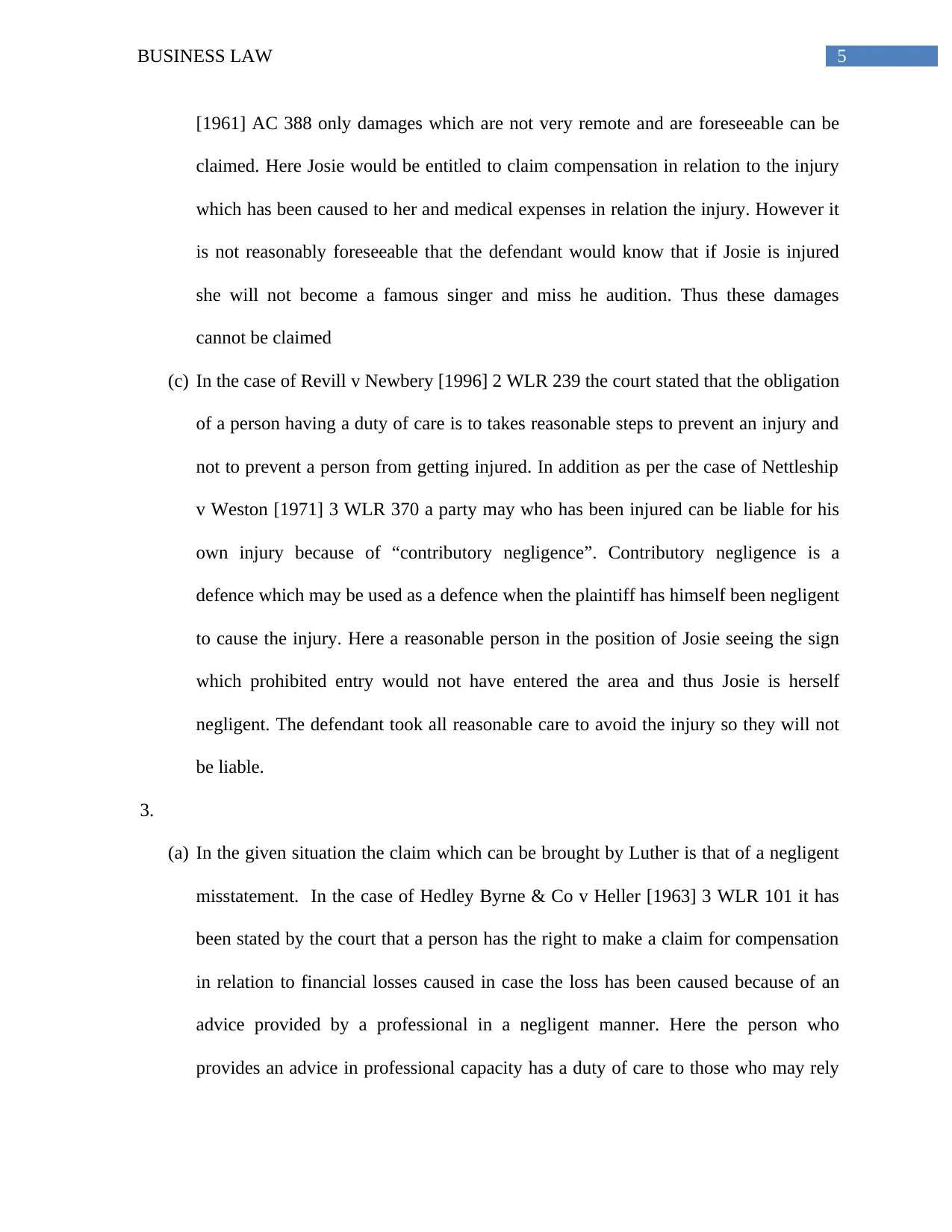
5BUSINESS LAW
[1961] AC 388 only damages which are not very remote and are foreseeable can be
claimed. Here Josie would be entitled to claim compensation in relation to the injury
which has been caused to her and medical expenses in relation the injury. However it
is not reasonably foreseeable that the defendant would know that if Josie is injured
she will not become a famous singer and miss he audition. Thus these damages
cannot be claimed
(c) In the case of Revill v Newbery [1996] 2 WLR 239 the court stated that the obligation
of a person having a duty of care is to takes reasonable steps to prevent an injury and
not to prevent a person from getting injured. In addition as per the case of Nettleship
v Weston [1971] 3 WLR 370 a party may who has been injured can be liable for his
own injury because of “contributory negligence”. Contributory negligence is a
defence which may be used as a defence when the plaintiff has himself been negligent
to cause the injury. Here a reasonable person in the position of Josie seeing the sign
which prohibited entry would not have entered the area and thus Josie is herself
negligent. The defendant took all reasonable care to avoid the injury so they will not
be liable.
3.
(a) In the given situation the claim which can be brought by Luther is that of a negligent
misstatement. In the case of Hedley Byrne & Co v Heller [1963] 3 WLR 101 it has
been stated by the court that a person has the right to make a claim for compensation
in relation to financial losses caused in case the loss has been caused because of an
advice provided by a professional in a negligent manner. Here the person who
provides an advice in professional capacity has a duty of care to those who may rely
[1961] AC 388 only damages which are not very remote and are foreseeable can be
claimed. Here Josie would be entitled to claim compensation in relation to the injury
which has been caused to her and medical expenses in relation the injury. However it
is not reasonably foreseeable that the defendant would know that if Josie is injured
she will not become a famous singer and miss he audition. Thus these damages
cannot be claimed
(c) In the case of Revill v Newbery [1996] 2 WLR 239 the court stated that the obligation
of a person having a duty of care is to takes reasonable steps to prevent an injury and
not to prevent a person from getting injured. In addition as per the case of Nettleship
v Weston [1971] 3 WLR 370 a party may who has been injured can be liable for his
own injury because of “contributory negligence”. Contributory negligence is a
defence which may be used as a defence when the plaintiff has himself been negligent
to cause the injury. Here a reasonable person in the position of Josie seeing the sign
which prohibited entry would not have entered the area and thus Josie is herself
negligent. The defendant took all reasonable care to avoid the injury so they will not
be liable.
3.
(a) In the given situation the claim which can be brought by Luther is that of a negligent
misstatement. In the case of Hedley Byrne & Co v Heller [1963] 3 WLR 101 it has
been stated by the court that a person has the right to make a claim for compensation
in relation to financial losses caused in case the loss has been caused because of an
advice provided by a professional in a negligent manner. Here the person who
provides an advice in professional capacity has a duty of care to those who may rely
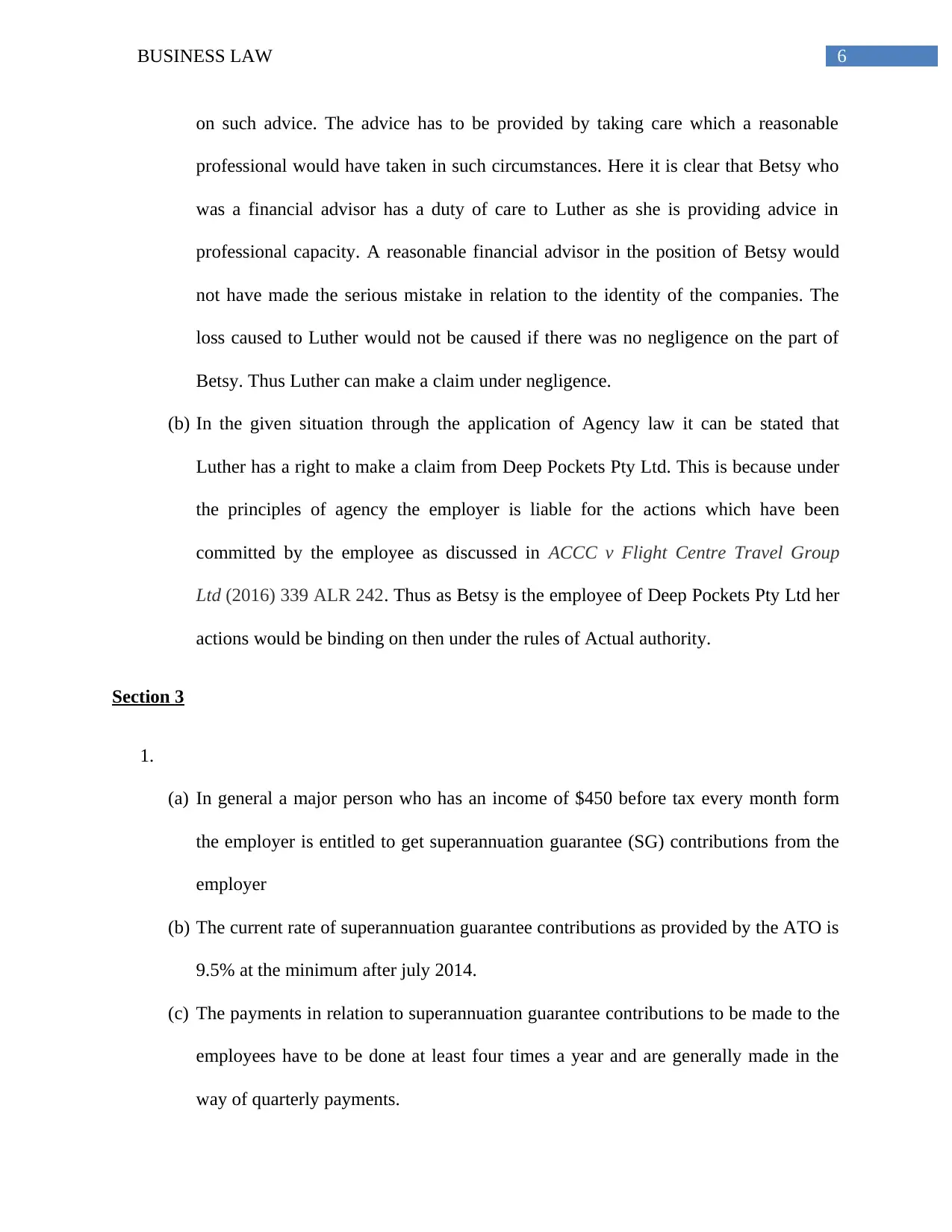
6BUSINESS LAW
on such advice. The advice has to be provided by taking care which a reasonable
professional would have taken in such circumstances. Here it is clear that Betsy who
was a financial advisor has a duty of care to Luther as she is providing advice in
professional capacity. A reasonable financial advisor in the position of Betsy would
not have made the serious mistake in relation to the identity of the companies. The
loss caused to Luther would not be caused if there was no negligence on the part of
Betsy. Thus Luther can make a claim under negligence.
(b) In the given situation through the application of Agency law it can be stated that
Luther has a right to make a claim from Deep Pockets Pty Ltd. This is because under
the principles of agency the employer is liable for the actions which have been
committed by the employee as discussed in ACCC v Flight Centre Travel Group
Ltd (2016) 339 ALR 242. Thus as Betsy is the employee of Deep Pockets Pty Ltd her
actions would be binding on then under the rules of Actual authority.
Section 3
1.
(a) In general a major person who has an income of $450 before tax every month form
the employer is entitled to get superannuation guarantee (SG) contributions from the
employer
(b) The current rate of superannuation guarantee contributions as provided by the ATO is
9.5% at the minimum after july 2014.
(c) The payments in relation to superannuation guarantee contributions to be made to the
employees have to be done at least four times a year and are generally made in the
way of quarterly payments.
on such advice. The advice has to be provided by taking care which a reasonable
professional would have taken in such circumstances. Here it is clear that Betsy who
was a financial advisor has a duty of care to Luther as she is providing advice in
professional capacity. A reasonable financial advisor in the position of Betsy would
not have made the serious mistake in relation to the identity of the companies. The
loss caused to Luther would not be caused if there was no negligence on the part of
Betsy. Thus Luther can make a claim under negligence.
(b) In the given situation through the application of Agency law it can be stated that
Luther has a right to make a claim from Deep Pockets Pty Ltd. This is because under
the principles of agency the employer is liable for the actions which have been
committed by the employee as discussed in ACCC v Flight Centre Travel Group
Ltd (2016) 339 ALR 242. Thus as Betsy is the employee of Deep Pockets Pty Ltd her
actions would be binding on then under the rules of Actual authority.
Section 3
1.
(a) In general a major person who has an income of $450 before tax every month form
the employer is entitled to get superannuation guarantee (SG) contributions from the
employer
(b) The current rate of superannuation guarantee contributions as provided by the ATO is
9.5% at the minimum after july 2014.
(c) The payments in relation to superannuation guarantee contributions to be made to the
employees have to be done at least four times a year and are generally made in the
way of quarterly payments.
Paraphrase This Document
Need a fresh take? Get an instant paraphrase of this document with our AI Paraphraser

7BUSINESS LAW
(d) Superstream is a standard of the federal government which is used for the purpose of
processing superannuation payments and data electronically. The primary purpose of
the Superstream is to enhance the efficiency of the superannuation system and has to
be mandatorily used by the APRA-regulated funds, self-managed super funds and
employers.
(e) No the superannuation obligations in relation to a partnership and sole trader is not
the same in relation to trusts and companies. This is because a sole trader or in
partnership superannuation is not required to be paid to the owners where as the trusts
and companies superannuation has to be paid to directors and trustees.
2.
(a) TFN and ABN has to be registered by any person who is conducting a business in
Australia regardless of the business structure which has been selected by them.
(b) Any business which has the turnover is over the $75,000 threshold or is likely to
exceed it has the obligation to the get itself registered for Goods and services Tax.
(c) Businesses pay tax to the ATO for themselves and their employees by deducting
PayG or paying for fringe benefits tax for the employers as well their own income
tax
(d) Generally businesses have to keep a record of taxes for a period of five years.
(d) Superstream is a standard of the federal government which is used for the purpose of
processing superannuation payments and data electronically. The primary purpose of
the Superstream is to enhance the efficiency of the superannuation system and has to
be mandatorily used by the APRA-regulated funds, self-managed super funds and
employers.
(e) No the superannuation obligations in relation to a partnership and sole trader is not
the same in relation to trusts and companies. This is because a sole trader or in
partnership superannuation is not required to be paid to the owners where as the trusts
and companies superannuation has to be paid to directors and trustees.
2.
(a) TFN and ABN has to be registered by any person who is conducting a business in
Australia regardless of the business structure which has been selected by them.
(b) Any business which has the turnover is over the $75,000 threshold or is likely to
exceed it has the obligation to the get itself registered for Goods and services Tax.
(c) Businesses pay tax to the ATO for themselves and their employees by deducting
PayG or paying for fringe benefits tax for the employers as well their own income
tax
(d) Generally businesses have to keep a record of taxes for a period of five years.
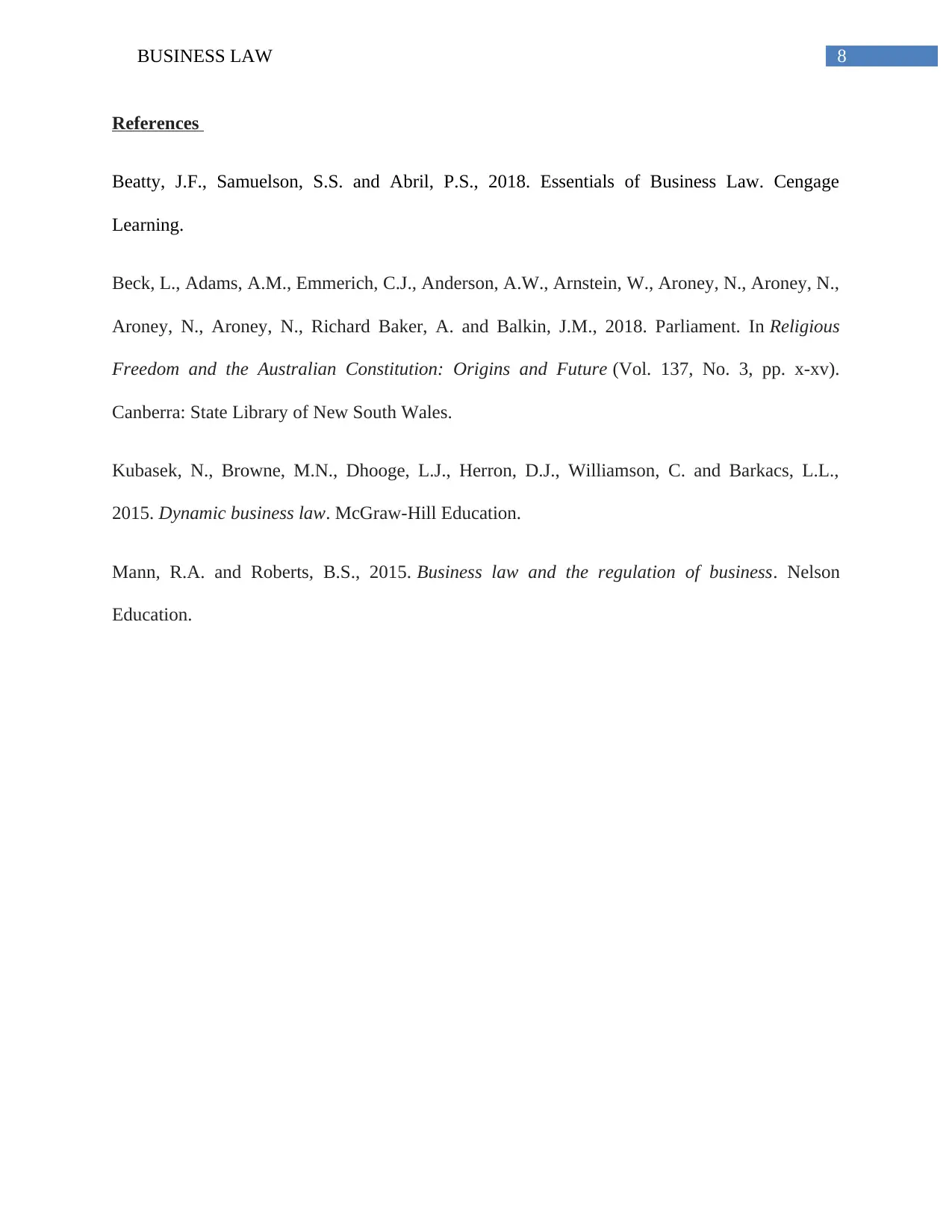
8BUSINESS LAW
References
Beatty, J.F., Samuelson, S.S. and Abril, P.S., 2018. Essentials of Business Law. Cengage
Learning.
Beck, L., Adams, A.M., Emmerich, C.J., Anderson, A.W., Arnstein, W., Aroney, N., Aroney, N.,
Aroney, N., Aroney, N., Richard Baker, A. and Balkin, J.M., 2018. Parliament. In Religious
Freedom and the Australian Constitution: Origins and Future (Vol. 137, No. 3, pp. x-xv).
Canberra: State Library of New South Wales.
Kubasek, N., Browne, M.N., Dhooge, L.J., Herron, D.J., Williamson, C. and Barkacs, L.L.,
2015. Dynamic business law. McGraw-Hill Education.
Mann, R.A. and Roberts, B.S., 2015. Business law and the regulation of business. Nelson
Education.
References
Beatty, J.F., Samuelson, S.S. and Abril, P.S., 2018. Essentials of Business Law. Cengage
Learning.
Beck, L., Adams, A.M., Emmerich, C.J., Anderson, A.W., Arnstein, W., Aroney, N., Aroney, N.,
Aroney, N., Aroney, N., Richard Baker, A. and Balkin, J.M., 2018. Parliament. In Religious
Freedom and the Australian Constitution: Origins and Future (Vol. 137, No. 3, pp. x-xv).
Canberra: State Library of New South Wales.
Kubasek, N., Browne, M.N., Dhooge, L.J., Herron, D.J., Williamson, C. and Barkacs, L.L.,
2015. Dynamic business law. McGraw-Hill Education.
Mann, R.A. and Roberts, B.S., 2015. Business law and the regulation of business. Nelson
Education.
1 out of 9
Related Documents
Your All-in-One AI-Powered Toolkit for Academic Success.
+13062052269
info@desklib.com
Available 24*7 on WhatsApp / Email
![[object Object]](/_next/static/media/star-bottom.7253800d.svg)
Unlock your academic potential
© 2024 | Zucol Services PVT LTD | All rights reserved.




